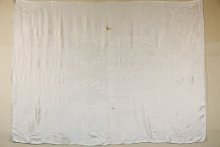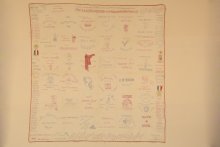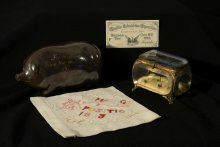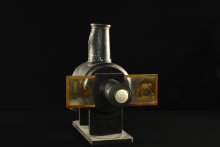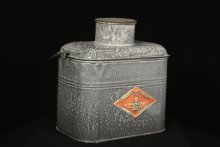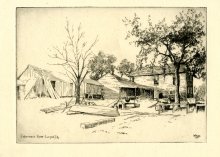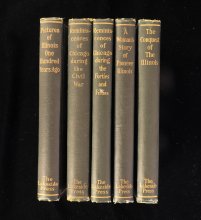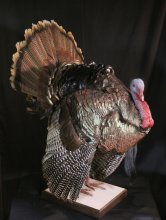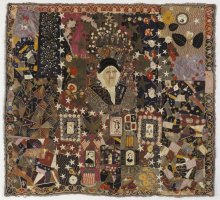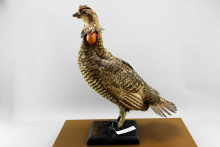Industrializing Illinois (1877-1917)
Following the Civil War, Illinois continued to grow in population, diversity, and complexity. Large-scale heavy manufacturing and a growing commercial sector joined agriculture as major employers of a rapidly growing population. Immigration continued, with African Americans from the South and southern and eastern Europeans joining more established groups. Conflicting interests sometimes led to unrest, strikes, and even violence. During this period, Illinois also became a center of exciting new movements in art, architecture, and literature.
In 1818, the year Illinois achieved statehood, this table runner was brought to Illinois from Virginia. It is woven with scenes from the Bible, including the Last Supper.
Charity Hedge Lingenfelter created this quilt in 1889 to raise money for the Women’s Relief Corps, an auxiliary to the Grand Army of the Republic. Proceeds from the sponsorship and sale of this quilt would go to help Union veterans of the Civil War, as well as their widows and orphans. Charity had a personal interest in the plight of Civil War veterans, as her husband, Aaron, had lost a finger while serving in the 55th Illinois Infantry.
Between May 1 and October 31, 1893, more than 12 million people visited the World’s Columbian Exposition in Chicago, which celebrated the 400th anniversary of Christopher Columbus’s discovery of America. More than 65,000 exhibits covered 600 acres on the city’s South Side, illuminated at night by hundreds of thousands of light bulbs. Visitors looked at new inventions, listened to lectures, saw art exhibits and sporting events, watched movies, rode the original Ferris Wheel, and tasted new foods such as shredded wheat and Juicy Fruit gum.
In the era before moving pictures, magic lantern shows were a popular form of entertainment. An early precursor of a slide projector, this device used the light of a candle or oil lamp to project images on a wall or screen from glass slides. Public magic lantern shows entertained audiences with projected images, narration, and live music. Smaller models of magic lanterns were available for home use and were especially popular as holiday gifts.
This dinner bucket was used by a working man to carry lunch to his job site. It is a rare surviving example of the oblong bucket produced by the National Enamel and Stamping Company (NESCO) of Granite City.
Lee Sturges (1865-1954) was a prolific artist and inventor who was born in Chicago and lived in Elmhurst from 1892 until the year before he died in 1954. In his career as a businessman and engineer, he helped found the Illinois Manufacturers Association in 1893. Throughout his life, Sturges was awarded patents for 20 inventions, including a small-scale etching press that led to a revival of the medium.
Lakeside Classics are books published by R.R. Donnelley & Sons that feature first-person narratives of American history. Since 1903, the books have been released every Christmas, a practice that continues today. However, the books are not sold to the public but instead have been given to employees and others associated with the company.
The bird that was center stage at the first Thanksgiving, and Benjamin Franklin’s choice to be our national symbol, almost disappeared from Illinois forever. Like many other species of game animals, from beaver to otters to White-tailed Deer, the Eastern Wild Turkey was almost gone from the state in the early 1900s. Hunting seasons were closed in 1903, but it was almost a case of “too little, too late.” It took the dedicated efforts of conservationists to re-establish the Eastern Wild Turkey in Illinois. Starting in the late 1950s, thousands of birds were captured in other states and relocated to Illinois in order to bolster populations.
This crazy quilt was created to commemorate the World’s Columbian Exposition, which was held in Chicago in 1893 to celebrate the 400th anniversary of Christopher Columbus’s discovery of the Americas. An image of Columbus occupies the center of the quilt. Below him are images of Bertha Palmer, one of the Fair’s organizers; George Washington; an unidentified woman; President Grover Cleveland, who opened the fair on May 1, 1893; and the Duke of Veragua of Spain, the only living descendant of Christopher Columbus at the time.
The Greater Prairie Chicken was once abundant in Illinois. Due to severe habitat loss, populations of the Prairie Chicken went from an estimated 10 million in the mid 1800s to less than 200 individuals today. This species does not migrate.
Pages






